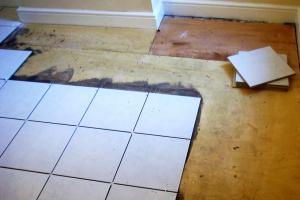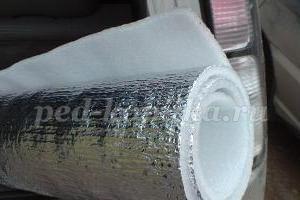Quite often you can encounter a situation when a bathtub breaks down, but the possibility of its high-quality replacement in this moment does not exist. What needs to be done in this case? If there is insufficient funds to purchase a new bathtub or if there is no possibility of dismantling this structure, a situation inevitably arises that requires restoration of the damaged bathtub. We will talk about this procedure in our article.
So, bathtub restoration - where does it begin and what is needed to carry out this process? Restoration of a bathtub can be carried out using several methods, and each of them has a number of advantages and disadvantages.
The most optimal and quick way restore a damaged bathtub - make a special insert in it from a special acrylic sheet. The size of such a sheet should completely match the size of the bathroom itself, but its thickness should vary between 5-7 mm. The acrylic sheet is attached to the bathtub using construction polyurethane foam. After this procedure, the bath should dry for seven hours and after that the structure can be used for its intended purpose. The main disadvantages of this method of restoration are the instability of the acrylic insert to strong mechanical damage, the possibility of peeling off the glued acrylic sheet from the base of the bathroom or incorrect selection color range(in this case, the acrylic insert will stand out unattractively against the general background of the bathroom).
The next way to restore a damaged bathtub is to completely replace its enamel. This method requires much more material costs. At the same time, before carrying out a new enameling of the bathtub, it is necessary to take care of proper preparation designs for this procedure. First you need to remove it from the bathtub old layer enamels. To do this, use sandpaper. Then the cleaned surface must be checked for potholes and cracks. If there are any, then it is important to properly treat them with special putty compounds for bathtubs. Then it is necessary to degrease the surface of the bathroom. Before enameling, the bath must be well heated so that the layers of enamel lie smoothly and are perfectly absorbed. Then you can proceed directly to enameling. To do this, take an enamel solution and a special painter’s set - several brushes and a roller. The enamel is applied in several layers to the bathroom surface, and each layer should be distributed evenly over the surface of the bathroom. After applying all layers of enamel, its thickness on the bathroom should be no more than 1.5 mm and no less than 0.5 mm. This coating can last a short amount of time (about 7 years). The main advantages of this method of restoration are the ability to choose an unusual color (the color options of bathtub enamel are quite varied). Among the disadvantages of this method are low enamel quality indicators, short service life of the enamel coating and the appearance of roughness on the surface of the bathroom after enameling.
Restoring bathtubs to a very high standard high level can be done through the use of a special universal material called star acrylic. This product has positive characteristics of strength and quality. Star acrylic is a wear-resistant and impact-resistant type of enamel, which is based on liquid acrylic. Restoring a bathroom with this product is in many ways similar to restoring it with regular enamel. The only difference lies in the fact that liquid acrylic is not applied to the surface with a brush or roller. It is simply poured onto the walls of the bathroom, trying to ensure that the product completely covers them. The remaining starcryl simply flows into the bathroom drain. This treatment allows you to get a very smooth and shiny bathroom surface, without any roughness. However, this method also has a significant drawback - star acrylic is very susceptible to mechanical damage and scratches, so a bathtub that has such a coating must be treated with special care.
I would also like to add that the duration of use of the coating in your bathroom will depend not only on the chosen means for its restoration. Much here depends on the company that carried out the restoration of your bathroom. The more experienced the specialists are, the longer the coating will last in your bathroom. Also, when restoring a bathroom, pay attention to the fact that you should not use abrasives to clean the bathroom surface. They will scratch the surface and this will quickly lead to damage to the surface and failure of the bath.
Over time, the bath loses its attractiveness appearance. Smudges and traces of rust appear, the gloss disappears, and it becomes rough to the touch. Everything says it's time old bath change. And these are not small expenses. In addition, when replacing a bathtub, you cannot do without renovating the entire bathroom, and small expenses will turn into medium, or even large ones. But there is an alternative - do-it-yourself bathtub restoration. Available on the market a large number of materials with which you can independently update your bathtub with the proper quality.
Bathroom restoration methods
Now there are three methods for restoring old bathtubs:
1. Restoration of the enamel surface of the bathtub.
2. Restoration with liquid acrylic.
3. Restoration by installing an insert.
Method 1: ordinary enamel
Cast iron and steel enameled bathtubs are the most common types of bathtubs in our apartments. They are produced according to GOST 18297-96, which has been in force since 1997. According to this GOST, the warranty on bathtubs is 2 years. But as practice shows, the enamel on them lasts no more than 10 years of use.
Enamel is applied quite simply to bathtubs in the factory. First, the outer surface is heated red-hot, then inner surface sift the enamel powder and leave for some time to sinter the powder with the metal. Heat the outer surface again until the powder melts. The result is a smooth, glossy enamel coating. It is clear that at home this method of restoration cast iron bath, just like steel, is not suitable.
Why does enamel usually wear out?
Wear of the enamel surface occurs as a result of two factors:
- The use of cleaning products containing abrasive powders or substances with chlorine inclusions.
- The use of chemical reagents when cleaning water supply networks.
As a result of many years of exposure to these factors, the enamel surface of the bathtub becomes thinner, becomes rough and begins to rust.
Restoration of an enamel surface
Restoring enamel with your own hands is a fairly simple process. It consists of two stages: preparing the surface and applying a new layer of enamel.
What will you need for work?
You will need the following tools and materials:
- electric drill with a grinding wheel attachment;
- abrasive powder;
- sandpaper;
- rust converter (for example, “Tsinkar”);
- degreaser (for example, Nefras);
- lint-free napkin;
- natural bristle brushes or spray bottle;
- respirator and gloves;
- enamel, preferably two-component (enamel plus hardener).
Preliminary stage: surface preparation
Very important stage. The more thoroughly the bathtub surface is cleaned, the better the quality of the new enamel layer.
- old enamel is sprinkled with abrasive powder and cleaned off using sandpaper or a grinding wheel mounted on an electric drill;
- treat areas affected by corrosion with a rust converter, leave for half an hour, then clean with sandpaper;
- wash off the enamel and crumbs with water;
- thoroughly treat the bathtub with a degreaser using a lint-free cloth;
- fill the bath hot water and let it warm up for 10 minutes;
- drain the water and wipe dry with a lint-free cloth; Make sure that there are no lint or other foreign elements left on the surface.
Main stage: applying enamel
- according to the manufacturer's instructions, mix the enamel and hardener in a certain proportion and mix thoroughly;
- apply the first layer of enamel with a brush or spray;
- maintain a certain period of time according to the instructions;
- apply a second layer of enamel.
This concludes the process of restoring an enamel bathtub with your own hands. It is advisable to wait at least a week before using the bath. This is exactly how long it takes for the enamel to completely polymerize.
The service life of the new enamel will be about 6-8 years.
Method 2: bathtub restoration with liquid acrylic
This method of restoring a bathtub appeared relatively recently, thanks to the advent of a special material - glass acrylic.
How do we restore?
Stacrylic is a two-component acrylic material developed specifically for the restoration of bathtubs. It consists of acrylic itself and a separately supplied hardener. When acrylic and hardener are combined, the polymerization process begins, and when applied to the surface, the composition turns into a high-quality acrylic film with a thickness of 4 to 6 mm.
Advantages of glass
Stacryl has three remarkable properties that help it quickly and effectively restore a bathtub:
1. Viscosity
The optimally selected glass viscosity coefficient helps to easily create an acrylic coating with a thickness of 4 mm on the walls of the bathtub and 6 mm on its bottom.
2. Fluidity
The fluidity effect allows the glass to independently envelop the surface of the bathtub and lay down in an even layer.
3. Delayed polymerization
Thanks to this quality, you can calmly and relatively comfortably carry out work on the restoration of the bathtub, without fear that the acrylic will harden too quickly.
Once polymerized, the acrylic surface has mechanical and impact strength far superior to an acrylic liner or enamel layer.
Work execution technology
The technology for restoring bathtubs with liquid acrylic is even simpler than the enameling process and is as follows:
1: Surface preparation
This stage is no different from the restoration of an enamel surface. Repeat the same steps. Then disconnect the siphon and place a container under the bathtub drain where excess acrylic will drain.
2: Applying liquid acrylic
- prepare the acrylic mixture according to the manufacturer's instructions;
- slowly pour the finished mixture onto the upper edge of the bathtub; as soon as the stream reaches the middle, we begin to smoothly move the stream of glass around the perimeter of the bathtub;
- when the circle is closed, repeat the procedure, starting from the middle.
The process of pouring restoration must take place continuously; for this you need to take a glass container of a suitable size. You shouldn’t skimp – it’s better to pour out a little more acrylic than not have enough of it; the excess will go into the container under the drain hole.
Acrylic polymerizes, depending on the type, from one to four days. Choose glass acrylic with a long drying time; in this case, the acrylic surface will be of higher quality.
The service life of the restored bath will be about 20 years.
Method 3: bathtub restoration using a liner
The simplest, but also the most expensive method of restoration is installing an insert. In addition, it is impossible to completely restore the bathtub with your own hands using this method, since the liner is manufactured in a factory.
There is an option to order the production of a liner for a specific bathtub at the enterprise, and install it yourself.
The technology for installing the liner is as follows:
- thoroughly clean and degrease the surface of the bathtub;
- insert the manufactured liner into the bathtub;
- check the correct connection of the drain holes;
- cut the liner along the line of the wall tiles;
- apply special glue to the inner surface of the bathtub and the outer side of the liner and join them;
- The joints are additionally sealed with silicone.
After installing the liner, pour into the bath cold water and leave it for a day. After this, the restored bathtub is ready for use.
The insert will last you up to 10 years.
How much will it cost to restore a bathtub?
In conclusion, we will conduct comparative analysis the cost of restoring a bathtub, based on the methods discussed above.
Bathtub enameling
The cost of high-quality enamel “Reaflex 50” produced by the Finnish company “Tikkurila” is 550 rubles per 1 kg. The Russian restoration kit “Svetlana” costs 750 rubles. As a result, you will have to pay 1300 rubles.
Self-leveling restoration
If you buy a kit for restoring a bathtub with liquid acrylic, for example Plastall, it will cost about 2,000 rubles. By the way, it has everything you need for independent work, even a CD with a video lesson.
Acrylic liner
The cost of the liner itself and polymer glue ranges from 2800 to 3000 rubles.
The best option is the self-leveling restoration method, in which you will get a beautiful and durable coating for little money. Moreover, any of these methods is several times cheaper than purchasing and installing a new bathtub.
The bathtub is an invariable attribute of bathrooms, and pleases the eye with its cleanliness and whiteness. This is the best case scenario, but otherwise a bathtub, shabby and scratched, with rusty spots and smudges, becomes a source of bad mood and irritation. Yes, yes, psychologists have noted this important feature in people prone to depression.
And this is not surprising, because when you see a clean and elegant bath, you immediately associate it with warmth and bliss, relaxation and pleasure, which invariably accompanies those who like to take a bath.
Previously, when making baths, they did not spare cast iron, covering it with a layer of enamel. Such baths were eternal, but heavy. Over time, the enamel cracks and becomes stained, but the bath itself remains undamaged. It is possible to replace an old bathtub with a new steel one, but we understand that to do this we need to tear it off the wall, damaging the tiles in the process. And another question: will a thin-walled new bathtub be better than the old one?
Due to the fact that a new bathtub is quite expensive, and the old one is no good, the question arises: how can you restore an old bathtub? Thanks to modern technologies this can be done easily and simply. The restoration uses liquid acrylic, a material that makes it possible to restore bathtubs made of any material.
Until relatively recently, restoration of old bathtubs was carried out by covering the walls with a layer of enamel. New modern technology using liquid acrylic as a material is distinguished by its impact resistance and increased wear resistance.
The material itself has an important property - good fluidity, which allows it to be effectively applied to the walls of the bathtub by pouring acrylic. Restoring a bathtub with acrylic ensures a fairly uniform coating of the walls, filling existing chips, cracks and other possible defects.
Restoring bathtubs with liquid acrylic has obvious advantages:
- This may only take a few hours.
- A new refinished bathtub comes with a minimum 2 year warranty.
- During restoration there is no need to dismantle spare parts from the bathtub.
- At least 10, or even 15 years of good condition of the bathtub with careful use.
- The new bathtub becomes warmer due to the acrylic layer, which has good thermal conductivity.
- The coating will be smooth and even, without roughness or bubbles.
- Over time, the material does not darken or turn yellow, remaining glossy and snow-white.
- Acrylic does not break from impacts, does not wear off and does not scratch.
- The material has no odor.
- Acrylic is not susceptible to corrosion and the effects of acids and alkalis.
- And finally, in terms of money, restoring an old bathtub is cheaper than buying new equipment.
Restoration of bathtubs with liquid acrylic is carried out using technology from the world's leading acrylic manufacturers. Of all the brands of acrylic, they prefer to use brands that are of unsurpassed quality and fully meet international standards.
 These include:
These include:
- Du Pont (France);
- Byk Chemie (Germany);
- Evonik (Germany);
- Dow (Germany).
Restoring an old bathtub can also be done using an acrylic liner, but during use there were cases when water flowed under the liner, and the bathtub had to be restored again. This could be due to the negligence of the craftsmen themselves performing the work, as well as if cheaper material was used during the restoration.
It should be noted that the technology for obtaining a flawless new bathtub, as well as fast and comfortable work masters are directly related to the properties of acrylic. The fact is that acrylic has fluidity, viscosity and the ability to harden slowly, which allows you to cover an old bathtub with a thickness of 4 to 6 mm on the walls and bottom, respectively. Fluidity and viscosity allow acrylic to flow slowly and spread evenly under the influence of gravity.
How much can you save by covering an old bathtub with acrylic? At first, the cost of acrylic is really scary, but if you break everything down, you get the following picture:
- A new bathtub costs, depending on the material, from 10,000 to 15,000 rubles.
- To simply disassemble the old bathtub and take it out, you will need at least 2000-4000 rubles.
- Installing a new bathtub will require another 2000-4000 rubles.
Total - it turns out that we have to spend from 14,000 to 23,000 rubles just to buy a bathtub and replace it. Add here the cost of the damaged tiles and the cost of the tiler's work. Then the cost of covering an old bathtub with acrylic (from 3500 to 3900 rubles) is not only inexpensive, but also very profitable.
Bathtub restoration technology with liquid acrylic
Restoring bathtubs with liquid acrylic requires careful preparation. repair work. The surface to be coated must be completely clean, and to do this, the old enamel is removed using an abrasive material. You can also do it manually, which is quite difficult and takes a lot of time.
Modern technologies suggest doing this using a drill with a special attachment in the form metal brush. This technology has a significant disadvantage - a lot of noise and a lot of dirt and dust. But there is a huge plus - the bathtub is cleaned in this way in about 20 minutes.
Dirt and dust are thoroughly washed down the drain, and the surface is treated with a special solvent that degreases the walls of the bathtub. To prevent acrylic from getting into the siphon, it is removed and after that the bath is ready for coating.
The technology has one more advantage - old cracks, chips, various roughnesses and places of other damage do not need to be leveled first, since the viscous and fluid acrylic, when drained, will cover the walls of the bathtub with an even layer. After the acrylic has drained, the bathtub will have a perfect appearance and a leveled surface.
Restoration with liquid acrylic has its own characteristics. Under the drain hole, at the location of the siphon, a container is installed so that excess acrylic drains from the walls of the bathtub. Then liquid acrylic is poured in thin streams along the edge of the side, smoothly moving around the perimeter of the entire bathtub. When applying acrylic, you must ensure that there is enough acrylic; excess residues flow into a container under the bathtub.
As soon as one circle ends, without stopping, begin the second circle and so on. There is no need to correct any irregularities, since they disperse on their own and do not remain on the walls. In this way, the liquid acrylic spreads in circles around the bath until the bottom is reached. Then all you have to do is wait until the acrylic dries.
The material usually takes several days to dry. Everything will depend on the layer and the degree of damage to the bathtub. If the old bathroom was badly damaged, it is filled with a thicker layer of acrylic, and this surface dries for 3-4 days. If the damage to the walls was minor, and an ordinary layer of acrylic is worn, which dries for 1-2 days.
The time until complete drying also depends on the material, since there are quick-drying and long-drying acrylic on sale. The question is often asked - which material is better? On the one hand, in 1-2 days you will receive new bath More tempting, but more even and strong, is acrylic that dries slowly and is covered in a thick layer.
This is not surprising, since acrylic has all the properties of cementitious materials that acquire their strength over time. So, for example, poured concrete is much stronger after 30-50 years than at the very beginning.

Operating rules and minor repairs of acrylic bathtubs
Ideally, if you don't drop anything or hit the tub, nothing will happen. But in life it happens that a crack appears in an acrylic bathtub. It would be stupid to immediately call a repair team and use their help to eliminate this defect. It just takes a little skill and patience to... This type of repair can save you a lot of time and money.
For repairs you will need some tools and required material for coating (epoxy glue). To prevent such defects from occurring again, it is necessary to remove all heavy objects from the bathroom to avoid a new crack or chip.
You may need your skill to make a bathtub screen with your own hands. Firstly, it is aesthetically pleasing, since the legs and bottom of the bathtub are not visible, and secondly, it can be a hidden niche for storing the same cleaning products.
And finally, before using your new bathroom, you need to know. This type of bathroom does not like abrasive powders and hard, scratching brushes. Such cleaning products may leave scratches on the walls of the acrylic bathtub. It is best to care for such a bathtub by rinsing after each bath and wiping it dry, and to disinfect and clean it from dirt, use regular washing powder.
Particular problems are caused by yellow spots or streaks that can appear on an acrylic bathtub due to the increased rust content in the water. The best way is to install a filter to purify water from rust, but if stains do appear, you can try to clean them with diluted lemon juice. Remember not to use acids or alkalis to clean the bathtub!
You may need knowledge and skill to install acrylic bath. This may be the case if you are renovating your bathroom and bought such a bathtub. Acrylic bath quite light compared to cast iron, and you should not have any questions about how, but more on this in another article.
Video instructions - Restoring bathtubs with liquid acrylic
Today there are 3 update methods old cast iron bath:
Restoring bathtub enamel.
Bathtub coating with acrylic.
Installing an acrylic liner into the bathtub.
Before deciding which method to choose, it is worth assessing the advantages and disadvantages of the methods restoring bathtub enamel, which you can read about in this article. The next step in restoring the surface is to prepare old cast iron bath before applying the coating (read about how to do it).
Now let's look at all 3 options for restoring the bathtub.
1. The mixture is applied clearly according to the instructions written on the package. It consists of enamel, hardener and dye. It should be kneaded slowly and carefully, avoiding the formation of foam.
The surface is covered with thin layers. It is best to use a brush with natural bristles, and in order to prevent lint from coming out of it when working, you should first coat its base with regular enamel. Then let it dry thoroughly.
3. After applying the first layer, it should be given the necessary time to dry completely. On average, this takes 30-60 minutes.
4. Then you can continue applying new layers. Their number varies from 4 to 7. The more layers applied to the old cast iron bath, the longer it will last.
When working with bath enamel, respirators must be used, as it has a very pungent and pungent odor that can be harmful to health. It is also worth noting that you need to have new brushes and gloves in stock so that, if necessary, they can be replaced without interrupting your work.
After finishing the work, the bathroom is closed for 5-7 days, depending on the number of layers applied. bath restoration. The more of them were done, the longer it will take the surface to dry. You should try not to enter the bath during this time. Otherwise, dust particles may settle on the enamel and stick to it, causing the surface to become unsmooth.

Fig. 1 Technology of applying enamel to an old cast-iron bathtub
This method also has the name self-filling bath. When applied, liquid acrylic spreads very evenly, thus forming an absolutely smooth and even surface.
The coating is made with a substance called stacryl. It consists of acrylic and a hardener made specifically for the surface of the bathtub. When applied, the composition is converted into a hard and durable coating with a thickness of 4 to 6 millimeters.
1. Liquid acrylic begins to be applied carefully to the sides of the bathtub, then, due to its viscosity, it independently begins to flow down the bathtub, thus forming a perfectly even coating.
2. Then the application is repeated in those places where the liquid acrylic has stopped flowing. Be sure to place any unnecessary container under the drain. It will collect the remains of glass, which can be reused if necessary.
3. If uncovered areas have formed, in this case, using rubber spatula they are carefully covered with liquid acrylic, which accumulates at the bottom of the bath.
4. If necessary, the edges of the bath are also finished using a rubber spatula. Applying one coat is more than enough. After finishing work, the room where the bath is located is tightly closed for 36 hours. This is the drying time for glass old cast iron bath. So do it yourself self-fill bath is quite real.

Fig. 2 Technology of covering a bathtub with acrylic
Before you start gluing the acrylic bowl inside the bathtub, it is worth considering that it must be inserted completely without any cutting of the sides. If this moment is neglected, then sooner or later water will begin to get into the cut edges and accumulate there. Because of this, a sewer smell forms in the room, and the inserted bowl begins to peel off over time. Therefore, do not neglect dismantling the bathtub, freeing all sides.
1. First of all, the liner is tried on in the bathtub in order to determine the location of the drain and overflow.
If it is not possible to install the liner completely in an old cast-iron bathtub, then all excess edges are cut off and subsequently glued silicone sealant.
3. When the liner is completely adjusted to the bathtub, it is time to apply glue specially designed for this purpose. It should be applied to the entire inner bowl old cast iron bath and on wrong side acrylic liner.
4. All edges of the joints are additionally treated with silicone sealant. This is done in order to prevent the possibility of water getting between the bathtub and the insert.
6. Then a drain and overflow system is installed. After which the bath is filled cold water and kept in this state for at least a day.
The result is a coating that is in no way inferior to a new bathtub.
In any case, when the shelf life of this product comes to an end, there is always the opportunity to give a second life to the bathtub in the form of a mini pond at the dacha, and read about how to do it in this article.

Fig. 3 Technology for installing an acrylic insert in an old cast-iron bathtub
I wonder what will happen tomorrow? If ten years ago no one thought of restoring a bathtub in any other way than by applying a second layer of enamel, now, thanks to modern technologies, it is possible to install an acrylic liner in an old bathtub within just a couple of hours or simply fill its inner surface with liquid acrylic . The result exceeds all expectations - you get a practically new bathtub, ready to serve you faithfully for at least another ten years.
If everything is more or less clear with the acrylic liner, then technology such as restoration of bathtubs with liquid acrylic looks quite vague and ambiguous. At least for those people who did not have to deal with it closely. And, having understood the process, everything becomes clear as daylight!
In fact, the technology itself using liquid acrylic is not complicated. More interesting from all points of view is the material itself used to restore the surface of the bathtub - “Stakryl”.
Qualities and properties of glass acrylic - liquid acrylic for baths
Glass acrylic is a material specially designed for bathtubs. That is why it has only those qualities that are necessary for comfortable work with it and obtain a high-quality coating.

Firstly, the combination of three properties of the liquid composition, which makes the work of the master quick and comfortable - viscosity, fluidity and its ability to harden immediately. These qualities are very important: viscosity or thickness allows you to create a new coating with a thickness of 4 mm on the walls and up to 6 mm on the bottom of the bathtub. Due to its fluidity, the mixture is independently distributed under the influence of gravity in a uniform and even layer over the entire surface of the bathtub, and the ability of glass to harden slowly helps in this not very fast process.
Secondly, a completely dry surface self-filling bath withstands loads much higher than an acrylic liner or ordinary enamel applied in a factory can withstand. Glass is almost impossible to damage. Unless, of course, you specifically set yourself this goal. It wears out for quite a long time and is practically not damaged by cleaning and household chemicals.
All this should be enough to choose this technology for restoring an old bathtub - bathtub restoration with liquid acrylic.

We seem to have figured out the properties of glass, all that remains is to find out how such a miracle coating is created. self-filling bath.
“Pour-in bath” technology – restoration of a bathtub with liquid acrylic
As elsewhere, before you begin applying a new coating, you need to carefully prepare the surface to be coated. Old enamel must be treated with an abrasive material. Doing this manually is quite difficult and time consuming, so a drill and a special metal brush are used for this purpose. There is a lot of dust and dirt, but the surface is quickly brought to the required condition.
After cleaning the old enamel, the dirt is washed off, the surface is degreased with a solvent, the siphon is removed and the bath is ready for applying a stacrylic coating.
The great thing about the pour-in bath technology is that there is no need to seal deep scratches and chips - spreading glass fills all the unevenness and levels the surface of the bathtub to an almost ideal state.
What's next? And then we place a container under the drain hole - excess glass will flow into it, and we begin to apply liquid acrylic. We pour it onto the edge of the side in a gentle stream and wait until the glass flowing down reaches the middle of the height of the bathtub, after which we begin to move the stream flowing from the bucket along the entire perimeter of the bathtub. We carefully ensure that there is plenty of liquid acrylic for the bath. Let there be a little more of it - the excess will drain into a container under the bath.
The “fill bath” operation must be carried out as a continuous process. Start pouring and do not stop until, having walked around the circle, you close the ring. You don't need to fix anything - you'll just ruin it. All drips and sagging will go away on their own. All you have to do is wait until the new surface of the bathtub dries.

And it dries from a day to four. It all depends on what kind of glass you use - there is a quick-drying material on sale (after a day the bathtub can be used) and a long-drying one (the bathtub is ready for use after four days). Which is better? The one that dries longer is better - the surface turns out a little better and stronger. Such are the properties of materials, and not just glass. For example, concrete gains its strength within 50 years.
And finally little advice For those who want to restore a bathtub with liquid acrylic, you should not dilute the material in order to save it in this way. This will result in a thin layer of coating that will not last very long.










